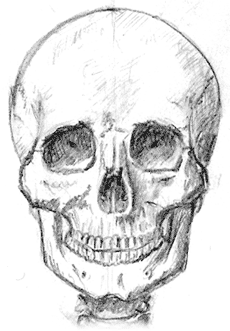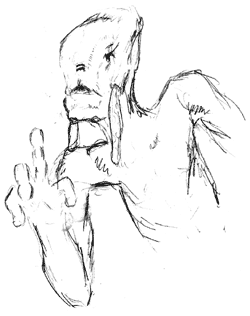 |
Introduction Site Map Email: jja@nac.net |

— Stanislaw Lem, Solaris


Monday, September 6th, 2004
I have more work do do on my entry, but it's a nice day out. I'll post it later this evening.
 Update: I've made progress on the Eaiean skull, but it's still hard for me to present it. In my effort to keep it
from looking too familiar, it's becoming a very complex object; perhaps too complex...
Update: I've made progress on the Eaiean skull, but it's still hard for me to present it. In my effort to keep it
from looking too familiar, it's becoming a very complex object; perhaps too complex...
The purpose of a skull as far as humans are concerned (left) is to protect fragile elements of the nervous and sensory systems. Eyes, ears and brains are delicate and easily damaged. This is likely to be true for the Eaie as well, though their sensory systems are different, as I'll describe below.
The skull is also likely to serve as an attachment point for any food processing appendages (jaws) the animal has. Why? It mainly has to do with early sensible design decisions. An animal ideally should be able to detect its prey, while pursuing it and while eating it. So the part that ingests (mouth) should be near any parts that detect (eyes and ears). Does the mouth need to be near the brain? Probably not directly, but delicate sensory organs probably would. Their being close probably aids reaction time, but the active principle may well be parsimony. An animal has only a certain amount of biological energy it can put towards development. Having separate armored areas for eyes, ears, etc. scattered all over the body would not be as efficient as keeping the most delicate parts all in one place and armoring that place well.
I don't mean to suggest here that natural selection worked in that order - that, for instance, the eye evolved in some place distant from the brain and moved closer over time like a halibut's distal eye - the fact of "eyes close to brain" was probably decided early on, and later selection paths had no choice but to run along this groove. Early 'decisions' have profound effect on later ones.
 To the right is my first concept of the Eaie. This concept is outdated in several ways but it will serve for now. At the time, I intended the dark spot where the 'eye' would be to be an earhole. The dangling flap of flesh was some form of energy detector which could be retracted into the raised channel alongside the head.
To the right is my first concept of the Eaie. This concept is outdated in several ways but it will serve for now. At the time, I intended the dark spot where the 'eye' would be to be an earhole. The dangling flap of flesh was some form of energy detector which could be retracted into the raised channel alongside the head.
In my redesign, I've changed many things. The dark spot would now correspond to a vestigial eye. (The Eaie went underground for several thousand years and eyes similar to ours were selectively inferior to eyes guarded by thickened, protective (but opaque) skin. The dangly bits might be a stretched earlobe of sorts; the ridge behind the head is now either an auditory channel or a sounding tube; perhaps both.
In the next entry, I'll have at least a side view of the Eaiean skull, and more discussion on why I designed it the way I'm doing.



pageatatime.com is hosted by net access corporation - www.nac.net